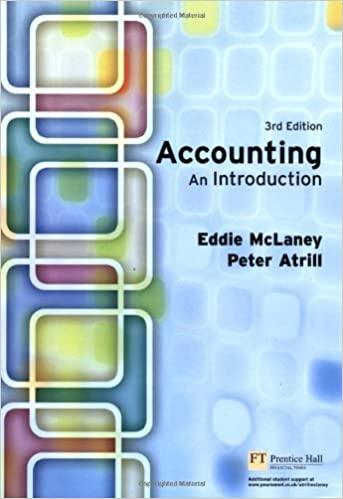Appendix: Normal and Abnormal Spoilage in Process Costing. Changes in Output Measures, Multiple Departments Grayson Company produces an industrial chemical used for cleaning and lubricating machinery. In the Mixing Department, liquid and dry chemicals are blended to form slurry. Output is measured in gallons. In the Baking Department, the slurry is subjected to high heat, and the residue appears in irregular lumps. Output is measured in pounds. In the Grinding Department, the irregular lumps are ground into a powder, and this powder is placed in 50 pound bags. Output is measured in bags produced. In April, the company reported the following data: a. The Mixing Department transferred 50,800 gallons to the Baking Department, costing $203,200. Each gallon of slurry weighs two pounds. b. The Baking Department transferred 101,600 pounds (irregular lumps) to the Grinding Department. At the beginning of the month, there were 4,700 gallons of slurry in process, 30 percent complete, costing $29,600 (transferred-in cost of $18,800 plus conversion cost of $10,800 ). No additional direct materials are added in the Baking Department. At the end of April, there was no ending work in process. Conversion costs for the month totaled $196,612. Normal loss during baking is 5 percent of good output. All transferred-in materials are lost, but since loss occurs uniformly throughout the process, only 50 percent of the conversion units are assumed to be lost. c. The Grinding Department transferred 2,540 bags of chemicals to its finished goods warehouse. Beginning work in process for this department was 25,000 pounds, 50 percent complete with the following costs: transferred-in cost, $134,000; conversion cost, $13,500. Bags are used at the end of the process and cost $1.20 each. During bagging, normally one out of every 11 bags is torn and must be discarded. No powder is lost (the tearing occurs when the bag is being attached to a funnel). Conversion costs for the month's production are $171,150. There is no ending work in process. Required: 1. Using FIFO, calculate the cost per bag of chemicals transferred to the finished goods warehouse. Round perunit costs to the nearest cent. Round other solutions to the nearest unit or dollar as needed. Baking Department (to obtain the cost of goods transferred out): Tetal equivalent units Tetal unit rowt Grinding Department: Total units acsounted for Note: (For direct materials: 11 bags are used to get 10 good bags). Note: (For direct materials: 11 bags are used to get 10 good bags). Unit cost of units started and completed: 2. Prepare the journal entry needed to remove spoilage from the Baking and Grinding departments. Round your answers to the nearest dollar if rounding is required. Appendix: Normal and Abnormal Spoilage in Process Costing. Changes in Output Measures, Multiple Departments Grayson Company produces an industrial chemical used for cleaning and lubricating machinery. In the Mixing Department, liquid and dry chemicals are blended to form slurry. Output is measured in gallons. In the Baking Department, the slurry is subjected to high heat, and the residue appears in irregular lumps. Output is measured in pounds. In the Grinding Department, the irregular lumps are ground into a powder, and this powder is placed in 50 pound bags. Output is measured in bags produced. In April, the company reported the following data: a. The Mixing Department transferred 50,800 gallons to the Baking Department, costing $203,200. Each gallon of slurry weighs two pounds. b. The Baking Department transferred 101,600 pounds (irregular lumps) to the Grinding Department. At the beginning of the month, there were 4,700 gallons of slurry in process, 30 percent complete, costing $29,600 (transferred-in cost of $18,800 plus conversion cost of $10,800 ). No additional direct materials are added in the Baking Department. At the end of April, there was no ending work in process. Conversion costs for the month totaled $196,612. Normal loss during baking is 5 percent of good output. All transferred-in materials are lost, but since loss occurs uniformly throughout the process, only 50 percent of the conversion units are assumed to be lost. c. The Grinding Department transferred 2,540 bags of chemicals to its finished goods warehouse. Beginning work in process for this department was 25,000 pounds, 50 percent complete with the following costs: transferred-in cost, $134,000; conversion cost, $13,500. Bags are used at the end of the process and cost $1.20 each. During bagging, normally one out of every 11 bags is torn and must be discarded. No powder is lost (the tearing occurs when the bag is being attached to a funnel). Conversion costs for the month's production are $171,150. There is no ending work in process. Required: 1. Using FIFO, calculate the cost per bag of chemicals transferred to the finished goods warehouse. Round perunit costs to the nearest cent. Round other solutions to the nearest unit or dollar as needed. Baking Department (to obtain the cost of goods transferred out): Tetal equivalent units Tetal unit rowt Grinding Department: Total units acsounted for Note: (For direct materials: 11 bags are used to get 10 good bags). Note: (For direct materials: 11 bags are used to get 10 good bags). Unit cost of units started and completed: 2. Prepare the journal entry needed to remove spoilage from the Baking and Grinding departments. Round your answers to the nearest dollar if rounding is required









